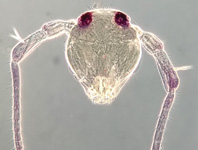Abstract
Here, we present the first two South American species of Nealiolus Mason (Hymenoptera, Braconidae), both reared from weevils damaging plants of economic value: Nealiolus chayohtli Wengrat & Shimbori sp. n. on Phymatophosus squameus feeding in stems of Sechium edule (chayote), and Nealiolus jaboticaba Shimbori & Wengrat sp. n. on Conotrachelus sp. in fruits of Plinia cauliflora (jaboticaba). This parasitoid genus is poorly studied, despite its potential importance as a biological control agent of several pest weevils (Curculionidae), including the cotton boll weevil. With the addition of the two new species, nine species of Nealiolus are known, three of them occurring in the Neotropical region. We also present an identification key to species of Nealiolus and DNA barcoding information for the new species.
References
Clark, W.E. (1978) Revision of the Neotropical weevil genus Phymatophosus (Coleoptera: Curculionidae). Systematic Entomology, 3, 103‒130.
Faust, J. (1896) Reise von E. Simon in Venezuela. Curculionidae. (pars tertia). Stettiner Entomologische Zeihmg, 57, 83‒84.
Folmer, O., Black, M., Hoeh, W., Lutz, R. & Vrijenhoek, R. (1994) DNA primers for amplification of mitochondrial cytochrome c oxidase subunit I from diverse metazoan invertebrates. Molecular Marine Biology and Biotechnology, 3, 294–297.
Fuentes, L.M.H., Vildozola, A.C. & Urias-Lopez, M.A. (2017) Weevil Borers in Tropical Fruit Crops: Importance, Biology and Management. In: Insect Physiology and Ecology. InTech, London, pp. 38–53.
Gilbert, M. T. P., Moore, W., Melchior, L. & Worobey, M. (2007) DNA Extraction from Dry Museum Beetles without Conferring External Morphological Damage. PLoS ONE, 2 (3), 4.
Kumar, S., Stecher, G., Li, M., Knyaz, C. & Tamura, K. (2018) MEGA X: Molecular evolutionary genetics analysis across computing platforms F. U. Battistuzzi (Ed). Molecular Biology and Evolution, 35 (6), 1547–1549.
López-Martínez, V., Sánchez-Garcia, J.A., Huerta-Paniogua, A. Calyecac-Cortero, G., Bautista-Martínez, N. & Figueroa-De La Rosa, J. (2006) Redescription of Nealiolus curculionis (Fitch) (Hymenoptera: Braconidae), with a new host record and distribution data. Proceeding of the Entomological society of Washington, 108 (2), 405‒410.
Martin, J.C. (1956) A taxonomic revision of the triaspidine braconid wasps of Nearctic America (Hymenoptera). Canadian Department of Agriculture Publication 965. Science Service, Entomology Division, Canada Department of Agriculture, Ottawa, 156 pp.
Mason, W.R.M. (1974) A generic synopsis of Brachistini (Hymenoptera: Braconidae) and recognition of the name Charmon Haliday. Proceedings of the Entomological Society of Washington, 76 (3), 235‒246.
Nylander, J.A.A. (2004) MrAIC.pl. Program distributed by the author. Evolutionary Biology Centre, Uppsala University, Uppsala. Available from: https://github.com/nylander/MrAIC (accessed 13 December 2019)
Papp, J. (2005) Eleven new species of Eubazus Nees species from Neotropical region (Hymenotpera: Braconidae: Brachistinae). Annales Historico-Naturales Musei Nationalis Hungarici, 93, 163‒195.
Ronquist, F. & Huelsenbeck, J.P. (2003) MrBayes 3: Bayesian phylogenetic inference under mixed models. Bioinformatics, 19 (12), 1572–1574.
Sharkey, M.J. (1997) Subfamily Helconinae. In: Wharton, R.A., Marsh, P.M. & Sharkey, M.J. (Eds.), Manual of the New World Genera of the Family Braconidae (Hymenoptera). International Society of Hymenopterists Special Publication, Washington, D.C., pp. 260–272.
Shaw, S.R. (1995) Braconidae. In: Hanson, P.E. & Gauld, L.D. (Eds.) The Hymenoptera of Costa Rica. Oxford University Press, London, 893 pp.
Sharanowski, B.J., Dowling, A.P.G. & Sharkey, M.J. (2011) Molecular phylogenetics of Braconidae (Hymenoptera: Ichneumonoidea), based on multiple nuclear genes, and implications for classification. Systematic Entomology, 36, 549– 572.
Soto, S.S. & Nakano, O. (2004) Parasitismo de braconídeos sobre Conotrachelus sp. em jabuticaba, em Piracicaba, SP, Brasil. Revista de Agricultura, 79 (1), 31‒36.
Tobias, V.I (1967) A review of the classification, phylogeny and evolution of the family Braconidae (Hymenoptera). Entomologicheskoye Obozreniye, 46 (3), 645–669.
Yu, D.S., van Achterberg, C. & Horstman, K. (2012) Taxapad 2012, Ichneumonoidea 2011. Taxapad, Ottawa, Ontario. [database on flash-drive]

